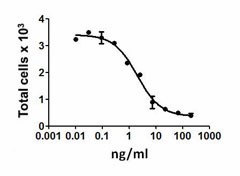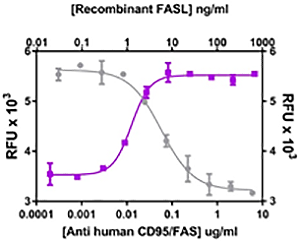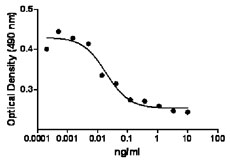- Regulatory Status
- RUO
- Other Names
- Tumor necrosis factor ligand superfamily, member 6 (TNFSF6), Apoptosis Antigen Ligand 1 (APT1LG1), apoptosis antigen Ligand, CD95 ligand (CD95L), Apo-1 ligand, CD178, Fas ligand
- Ave. Rating
- Submit a Review
- Product Citations
- publications

-

Apoptotic cell death induced by human FASL in Jurkat cells.
FASL was initially cloned and purified from a cytotoxic T cell hybridoma, PC60-d10S. FASL is a type II transmembrane glycoprotein of approximately 40 kD and belongs to the TNF family of membrane-associated cytokines. A soluble fragment of FASL (sFASL, 26-29 kD) has been described using in vitro proteolytic assays, and MMP7 was proposed to participate in this process. Nevertheless, TIMPs (tissue inhibitors of metalloproteinases) did not alter FASL shedding.
FASL is proteolytically cleaved by ADAM10, and it is the major protease responsible for FASL cleavage in murine fibroblasts and human T cells. The cleavage site is between Ser126 and Leu127. This site is outside of the self assembly (SA) domain that allows sFASL to form trimers. It has been suggested that FASL performs its biological activity as a homotrimer. Shedding of FASL modulates FASL/FAS dependent apoptosis and affects activation-induced cell death (AICD) in a superantigen stimulation model. It has published that sFASL has proapoptotic and antiapoptotic properties, depending of cell type and cell microenvironment.
sFASL can be detected in the serum of patients with dysregulated inflammatory diseases. Mutations in human FAS and FASL are associated to autoimmune lymphoproliferative syndrome (ALPS). In these patients, the homeostasis of T and B lymphocytes is disturbed, leading to hepatosplenomegaly and lymphadenopathy. Dysregulation of FAS/FASL has been connected to multiple diseases such as osteoarthritis, pulmonary fibrosis, diabetic polyneuropathy, acute coronary syndrome, bladder and gastric cancer among others.
Product Details
- Source
- Human FASL, amino acids N-Met-His8 (Pro134-Leu281) (Accession# NM_000639.1) was expressed in CHO cells.
- Molecular Mass
- The 157 amino acid recombinant protein has a predicted molecular mass of approximately 18 kD. The DTT-reduced and non-reduced protein migrate at approximately 29 to 30 kD by SDS-PAGE. The N-terminal amino acid is Met.
- Purity
- >90%, as determined by Coomassie stained SDS-PAGE.
- Formulation
- 0.22 µm filtered protein solution is in PBS.
- Endotoxin Level
- Less than 0.01 ng per µg cytokine as determined by the LAL method.
- Concentration
- 10 and 25 µg sizes are bottled at 200 µg/mL. 100 µg size and larger sizes are lot-specific and bottled at the concentration indicated on the vial. To obtain lot-specific concentration and expiration, please enter the lot number in our Certificate of Analysis online tool.
- Storage & Handling
- Unopened vial can be stored between 2°C and 8°C for up to 2 weeks, at -20°C for up to six months, or at -70°C or colder until the expiration date. For maximum results, quick spin vial prior to opening. The protein can be aliquoted and stored at -20°C or colder. Stock solutions can also be prepared at 50 - 100 µg/mL in appropriate sterile buffer, carrier protein such as 0.2 - 1% BSA or HSA can be added when preparing the stock solution. Aliquots can be stored between 2°C and 8°C for up to one week and stored at -20°C or colder for up to 3 months. Avoid repeated freeze/thaw cycles.
- Activity
- ED50 = 4.0 - 16 ng/ml, corresponding to a specific activity of 0.6 - 2.5 x 105 units/mg, as determined by the dose dependent stimulation of Jurkat death cell induced by apoptosis.
- Application
-
Bioassay
- Application Notes
-
BioLegend carrier-free recombinant proteins provided in liquid format are shipped on blue-ice. Our comparison testing data indicates that when handled and stored as recommended, the liquid format has equal or better stability and shelf-life compared to commercially available lyophilized proteins after reconstitution. Our liquid proteins are verified in-house to maintain activity after shipping on blue ice and are backed by our 100% satisfaction guarantee. If you have any concerns, contact us at tech@biolegend.com.
- Product Citations
-
Antigen Details
- Structure
- Homotrimeric
- Distribution
-
Cytotoxic lymphocytes (CTL), NK cells, neurons, astrocytes, and T cells
- Function
- FASL induces apoptotic cell death. It plays a key role in the immune system homeostasis, cytotoxic T cell (CTL)-mediated killing of virally infected or transformed cells, NK cell-mediated death cell, and termination of immune responses by induction of activation-induced cell death. ADAM10 modulates FASL-mediated cell death.
- Interaction
- Activate T and B cells, myeloid cells, thymocytes, fibroblasts, splenocytes, hepatocytes, variety of cell types
- Ligand/Receptor
- FAS (CD95)
- Cell Type
- Embryonic Stem Cells
- Biology Area
- Apoptosis/Tumor Suppressors/Cell Death, Cell Biology, Immunology, Neuroscience, Stem Cells
- Molecular Family
- CD Molecules
- Antigen References
-
1. Suda T, et al. 1993 Cell 75:1169.
2. Mitsiades N, et al. 2001 Cancer Res. 61:577.
3. Bodmer J, et al. 2002 Trends Biochem. Sci. 27:19.
4. Grassi F, et al. 2004 Arthritis Rheum. 50:498.
5. Bühling F, et al. 2005 Respir Res 6:37.
6. Schulte M, et al. 2007 Cell Death Differ. 14:1040.
7. Stranges PB, et al. 2007 Immunity 26:629.
8. Voss M, et al. 2008 Cell Commun. Signal 6:11.
9. Dowdell KC, et al. 2010 Blood 115:5164.
10. Gorbachev AV and Fairchild RL. 2010. Eur. J. Immunol. 40:2006. - Gene ID
- 356 View all products for this Gene ID
- UniProt
- View information about FASL on UniProt.org
Related FAQs
- Why choose BioLegend recombinant proteins?
-
• Each lot of product is quality-tested for bioactivity as indicated on the data sheet.
• Greater than 95% Purity or higher, tested on every lot of product.
• 100% Satisfaction Guarantee for quality performance, stability, and consistency.
• Ready-to-use liquid format saves time and reduces challenges associated with reconstitution.
• Bulk and customization available. Contact us.
• Learn more about our Recombinant Proteins. - How does the activity of your recombinant proteins compare to competitors?
-
We quality control each and every lot of recombinant protein. Not only do we check its bioactivity, but we also compare it against other commercially available recombinant proteins. We make sure each recombinant protein’s activity is at least as good as or better than the competition’s. In order to provide you with the best possible product, we ensure that our testing process is rigorous and thorough. If you’re curious and eager to make the switch to BioLegend recombinants, contact your sales representative today!
- What is the specific activity or ED50 of my recombinant protein?
-
The specific activity range of the protein is indicated on the product datasheets. Because the exact activity values on a per unit basis can largely fluctuate depending on a number of factors, including the nature of the assay, cell density, age of cells/passage number, culture media used, and end user technique, the specific activity is best defined as a range and we guarantee the specific activity of all our lots will be within the range indicated on the datasheet. Please note this only applies to recombinants labeled for use in bioassays. ELISA standard recombinant proteins are not recommended for bioassay usage as they are not tested for these applications.
- Have your recombinants been tested for stability?
-
Our testing shows that the recombinant proteins are able to withstand room temperature for a week without losing activity. In addition the recombinant proteins were also found to withstand four cycles of freeze and thaw without losing activity.
- Does specific activity of a recombinant protein vary between lots?
-
Specific activity will vary for each lot and for the type of experiment that is done to validate it, but all passed lots will have activity within the established ED50 range for the product and we guarantee that our products will have lot-to-lot consistency. Please conduct an experiment-specific validation to find the optimal ED50 for your system.
- How do you convert activity as an ED50 in ng/ml to a specific activity in Units/mg?
-
Use formula Specific activity (Units/mg) = 10^6/ ED50 (ng/mL)

 Login/Register
Login/Register 














Follow Us